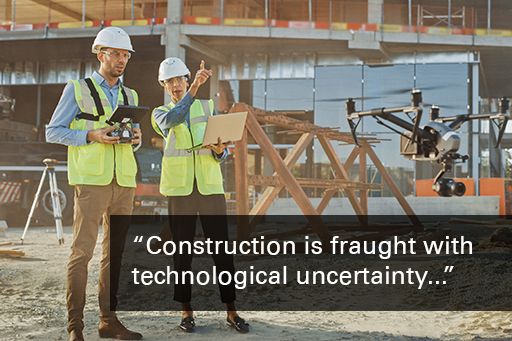The construction industry is a complex marketplace where multiple engineering technologies converge and combine to allow for the delivery of structures that have a commercial or societal purpose, and sometimes both, write Seamus Leahy and Gianmario Pala of our R&D Incentives practice.
The Irish construction industry has seen significant growth in recent years, with forecasts pre-COVID predicting similar outputs to the Celtic tiger era. Since the Celtic Tiger, strategic public planning has resulted in enhanced regulations for buildings and energy efficiency with investors driving the industry to adapt, innovate, and develop engineering based solutions to meet regulatory and consumer demand.
The onset of the COVID-19 pandemic has further changed the outlook. The industry has suffered a dramatic decrease in the production volume, and Q2 of 2020 in particular. As the lockdown began in March 2020, many construction sites ceased activity, resulting in a decrease in volume in all sectors, with the residential sector being most impacted.
The pandemic which led to the advent of remote working en masse has likely changed the requirements for buildings into the future – it will be interesting to see how new commercial office and retail developments will evolve as a result.
COVID-19 notwithstanding, if we consider the Irish governments pipeline for development of national infrastructure (Project Ireland 2040), we can see the diverse nature of construction projects being planned nationally. Capital investment is being made in medical, environmental and sustainability projects, which will likely require new innovations being achieved through R&D activities. This effort will be aided by continuing significant FDI, particularly in the multinational pharmaceutical, medical device and tech sectors – requiring unique engineering structures being developed to meet the demands of “Industry 4.0”.


Construction companies don’t innovate – is this true?
In a word, no! Construction companies, like any other industry, must continue to innovate or lose market share.
Sixteen years ago, the Irish Government introduced a tax-based incentive to encourage companies to invest in developing new products and processes, and to improve existing ones – the R&D Tax Credit. The value of R&D tax credits claimed in recent years peaked at €708m in 2015 while the number of claimants has remained relatively steady at approx. 1500 companies.
To date however, only a tiny fraction of the R&D tax credit has been made up of claimants from the construction sector - less than 5% of R&D claims (Source: Research and Development Tax Credit Statistics – April 2020). And indeed, this may be considered appropriate by some who believe that construction companies don't 'do' R&D. However, construction is fraught with technological uncertainty that requires new approaches to overcome.
A recent example we encountered involved a company undertaking the construction of a medical device facility which required a new and novel rigid support system to be developed. This involved investigating existing temporary framework construction methods which were hypothesised could be applied permanently and on a much larger scale than had ever previously been attempted. There were multiple phases of testing and simulation of the potential performance of the structure with various iterations being investigated, trialled and analysed. This activity has led to the resolution of a number of technological uncertainties and new knowledge in this field being generated. This is just one example of activity which may be considered for an R&D tax credit claim.
Eligible R&D may be difficult to detect in construction companies as unlike say, pharmaceutical or manufacturing, there is typically no specific R&D budget allocated to a given project. This is likely as a result of no client wishing to have a new building constructed that involves significant technological uncertainty!
So, what can be considered R&D?
Under the R&D tax credit legislation, qualifying R&D activities are defined as those which are systematic, investigative or experimental, seek to achieve new knowledge and involve the resolution of technological challenges. These activities can include the improvement of existing products, processes or services, as well as devising new ones. It is worth keeping in mind that R&D as defined under the legislation, is not just the domain of academics and their scientific advancements, but also includes technological advancements (i.e. advancements based on the practical implementation of scientific principles).
In the construction sector, activities which could qualify for the R&D tax credit (subject to the above requirements) may include the following:
- Design and engineering activities conducted in connection with HVAC systems, electrical systems and piping and plumbing systems. For example, the redesign of existing systems for building renovations, retrofitting facilities to meet updated codes or to support new uses, and the design of new building systems all involve technological uncertainty and the consideration of alternative design patterns.
- Resolving a system uncertainty where for example, older buildings have been refurbished with systems of varying ages leading to an integration challenge with the newer technology. This may have to be done in the context of meeting the demands of sustainability and restoration.
- Investigating the application of existing but older methods or developing new ones, particularly when dealing with older structures or newer “green” regulations. Determining how to apply existing methods to different challenges or development of newer, more effective or efficient methods to achieve the required result can all require qualifying R&D work.
- Buildings are large energy consumers and achieving significant energy and emissions reduction in the buildings sector is a challenging and technological process that involves the consideration of alternatives, technical uncertainty and in most cases a process of experimentation.
- The design of complex structures for constructability within restricted / challenging site constraints whilst maintaining or reducing build cost and time. For example, bridges in areas where flooding is common (i.e. rural areas) and maintenance is made difficult and costly because of geographical location.
- Development of sophisticated systems to meet health and safety requirements. For example, innovative scaffolding, safe working processes and automation.
- Investigating and designing framing plan alternatives to compare the individual material fabrication/erection costs to identify the most efficient and economical design for the structure.


Other R&D incentives
Another avenue which may be worthwhile exploring for construction companies is the many alternative R&D incentives available such as grants from Enterprise Ireland and the IDA.
These include the RD&I grant from the IDA which is a direct support mechanism granted via a pre-approval process. This can provide up to 25% support for R&D projects undertaking experimental development and is available to FDI companies located or planning to locate in Ireland to undertake RD&I. Broadly speaking, the RD&I project must accomplish a task of a precise economic, scientific or technical nature.
For indigenous companies, there are also a number of different grants available including the Larger RD&I grant from Enterprise Ireland which is intended to support the development of new or improved products, services or processes that will have both a) a competitive advantage, enabling companies to increase sales & employment, and b) export potential. The level of support available ranges from up to 45% for small companies or up to 25% for large companies. The type of companies eligible include Irish-based manufacturing or internationally traded services companies.
Conclusion
In construction, every project presents its own, unique set of challenges. New products, materials, processes and approaches developed in resolving these challenges can all count toward an R&D tax credit claim or indeed an R&D grant from Enterprise Ireland or the IDA.
In summary, it is clear that many of the activities undertaken by construction companies are challenging and could be considered for the R&D tax credit in the field of civil engineering or indeed RD&I grants. It would be a worthwhile exercise for construction companies to carefully consider the projects they are undertaking and reflecting on whether any elements of them could be deemed qualifying R&D.
This article originally appeared in Irish Building Magazine, and is reproduced here with their kind permission.
Get in touch
As Ireland’s leading R&D Incentives practice, KPMG assist companies in preparing both R&D tax credit claims and grant applications including drawdown of the amounts approved. We have significant experience of dealing with both Revenue in relation to the R&D tax credit and the granting authorities in gaining grant approval and managing the drawdown process.
If you have any queries relating to the use of the R&D Tax Credit in the construction sector, please contact Gianmario Pala or Seamus Leahy of our R&D Incentives practice. We'd be delighted to hear from you.
Our R&D team
Gianmario Pala
Director
KPMG in Ireland
Seamus Leahy
Associate Director
KPMG in Ireland


